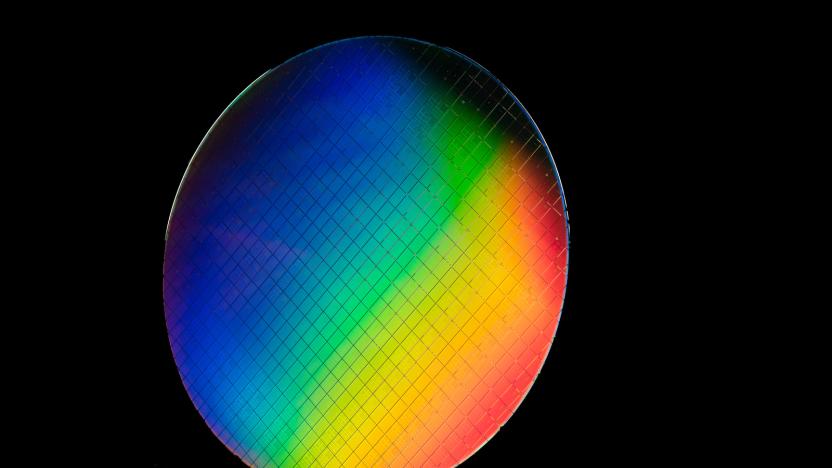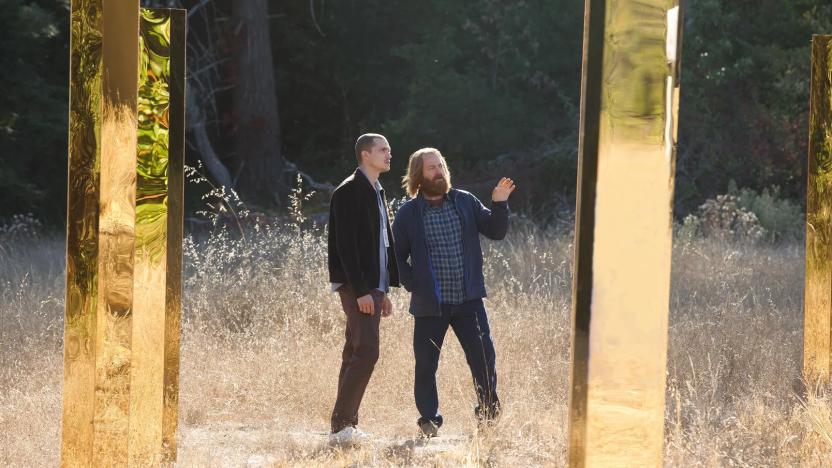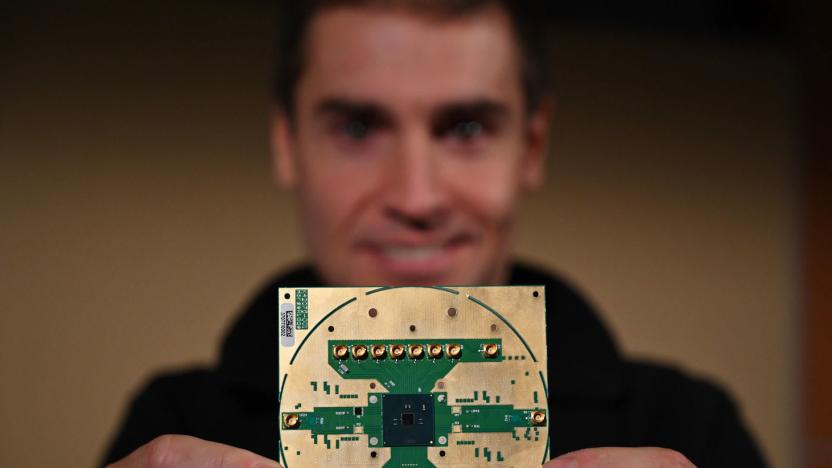quantum computing
Latest

Intel's 'hot' qubits could lead to more advanced quantum computers
Intel and QuTech have successfully controlled qubits that don't need to be chilled to the very edge of absolute zero.

Alex Garland on 'Devs,' free will and quantum computing
An interview with "Devs" creator Alex Garland, and how the FX/Hulu show explores the nature of free will with quantum computing.

Intel outlines chip that will make quantum computers smaller and faster
Intel is determined to play an important role in quantum computing, and it just outlined a component that will play a key part in that strategy. Intel and QuTech have provided some technical details for Horse Ridge, a previously-teased cryogenic control chip that should make quantum computers, smaller, faster and with less aggressive cooling. It won't lead to the dream of a true quantum computer, but it should get Intel considerably closer to that goal.

Google may have taken a step towards quantum computing 'supremacy' (updated)
Google may have made a breakthrough on the path toward creating a viable quantum computer -- or maybe not. In a draft of a research paper that was available on a NASA website and seen by the Financial Times, the company reportedly claimed to have achieved a feat known as "quantum supremacy," aka the potential ability of quantum computers to solve problems current technology can't even attempt.

‘Quantum microphone’ detects sound at the atomic level
Researchers at Stanford have developed a "quantum microphone" which can detect the smallest known units of sound -- packets of vibrational energy called phonons. The device could form the basis for even more efficient quantum computers.

Cloudflare wants to protect the internet from quantum computing
Quantum computing has the potential to revolutionize health care, AI, financial modeling, weather simulation and more. It's also going to shake up encryption as we know it. Without advances in post-quantum cryptography, quantum computing could make it easy for hackers to access sensitive data, like credit card info. To prevent that, internet infrastructure company Cloudflare is testing post-quantum cryptography technology, and it's sharing its open-source software package, CIRCL, or Cloudflare Interoperable Reusable Cryptographic Library, on GitHub.

Microsoft, Alphabet help you learn quantum computer programming
The very concept of a quantum computer can be daunting, let alone programming it, but Microsoft thinks it can offer a helping hand. It and Alphabet's X are partnering with Brilliant on an online curriculum for quantum computing. The course starts with basic concepts and gradually introduces you to Microsoft's Q# language, teaching you how to write 'simple' quantum algorithms before moving on to truly complicated scenarios. You can handle everything on the web (including quantum circuit puzzles), and there's a simulator to verify that you're on the right track.

Holographic tech could be key to future quantum computers
A breakthrough in studying light might just be the ticket to the future of quantum computing. Researchers at EPFL have found a way to determine how light behaves beyond the limitations of wavelengths, opening the door to encoding quantum data in a sci-fi style holographic light pattern. The team took advantage of the quantum nature of the interaction between electrons and light to separate beams in terms energy, not space -- that let them use light pulses to encrypt info on the electron wave and map it with a speedy electron microscope.

Google leaps into another quantum computing research project
Though the effectiveness of quantum computing is highly disputed right now, that hasn't deterred Google from throwing more money at it. Mountain View just announced that it's backing another effort to build a new breed of quantum processors with scientists from the University of California at Santa Barbara (UCSB). Google is already a partner at NASA's Quantum Artificial Intelligence Lab (QUAIL), and invested some $15 million in a D-Wave quantum computer for the project. However, a study done on a D-Wave's computer has cast doubt on the efficacy of the machine, a claim that was refuted by D-Wave as "bullshit." Intriguingly, several researchers involved in that study were also from UCSB -- like John Martinis, who has worked on quantum computing for nearly 30 years.

Microsoft explains quantum computing in a way we can all understand
Quantum computing -- it's a term we're hearing more and more, as companies such as D-Wave build their own early versions of super-machines. Microsoft, naturally, is investing considerable resources in the field as well; its Station Q research lab in Santa Barbara brings together experts studying topological quantum computing, with the goal of making a vastly more powerful successor to the classical computer. We've covered some quantum computing milestones in the past, and while you might have a basic grasp on the difference between qubits and bits, Microsoft's Quantum Computing 101 video -- published below -- is a well-done explainer, putting the implications of this research in human terms. For a deeper dive, check out this long read on Station Q, detailing the researchers' complex and thoroughly interesting work.

World record setting experiment brings quantum computing a step closer to reality
Despite recent successes in the field, creating a quantum computer is really hard. For one thing quantum bits in a super positioned state (or qubits, the basic unit of data for quantum computing) have a hard time surviving at room temperature. Typically, these superposition states last for only a few seconds, but in a recent experiment at Simon Fraser University in Burnaby , researchers were able to keep a quantum system alive for a full 39 minutes. "These lifetimes are at least ten times longer than those measured in previous experiments," explained Stephanie Simmons from the University of Oxford's Department of Materials. "Having such robust, as well as long-lived, qubits could prove very helpful for anyone trying to build a quantum computer." Even so, they aren't particularly active ones - all of the qubits in the experiment shared the same quantum state. To perform actual calculations (and thus build a functioning quantum computer), a system would need to put multiple qubtis in different quantum states. Sound complicated? It sure is, but it's a significant step forward to building the ultrafast computing platforms of tomorrow. Eager to learn more? Check out the official press release at the source link below. [Image Credit: Stephanie Simmons, University of Oxford]

Alt-week 9.22.12: Quantum Scotch tape, moving walls and scientific beer
Alt-week peels back the covers on some of the more curious sci-tech stories from the last seven days. Sometimes, here at alt.engadget.com, we're literally on the bleeding edge of technology. We get to explore concepts and ideas that are almost nebular in nature. Not this week though, where there's a distinct utilitarian aroma in the air. The glittery overcoat of future science is replaced by the rolled-up sleeves of good old-fashioned engineering. A bit of sticky tape, a proof of concept omnidirectional bike and a hardware matrix wall. After all that, you'll probably want a beer to wash it down with. Fortunately for you, it's all here. This is alt-week.

Researchers create working quantum bit in silicon, pave way for PCs of the future
If you've been paying attention, you know the quantum computing revolution is coming -- and so far the world has a mini quantum network, not to mention the $10,000 D-Wave One, to show for it. Researchers from the University of Melbourne and University College, London, have now developed the "first working quantum bit based on a single atom of silicon." By measuring and manipulating the magnetic orientation, or spin, of an electron bound to a phosphorus atom embedded in a silicon chip, the scientists were able to both read and write information, forming a qubit, the basic unit of data for quantum computing. The team used a silicon transistor, which detects the electron's spin and captures its energy when the spin's direction is "up." Once the electron is in the transistor, scientists can change its spin state any way they choose, effectively "writing" information and giving them control of the quantum bit. The next step will be combing two qubits into a logic step, with the ultimate goal being a full-fledged quantum computer capable of crunching numbers, cracking encryption codes and modeling molecules that would put even supercomputers to shame. But, you know, baby steps.

Lazaridis-backed Quantum-Nano Centre opens tomorrow, aims to be a new Bell Labs
Mike Lazaridis may now have a considerably smaller role at RIM, but he's isn't exactly receding from the technology scene in the company's hometown of Waterloo, Ontario. That's no more evident than in the Mike & Ophelia Lazaridis Quantum-Nano Centre opening tomorrow on the University of Waterloo campus, a science and technology research center that not only bears his name but was built with $100 million of his money. As Lazaridis makes clear in an interview with Bloomberg, he's also not modest about his ambitions for the center, noting that it is "absolutely" going to be the Bell Labs of the 21st century. Or, perhaps more specifically, a Bell Labs for quantum computing and nanotechnology, areas of research that Lazaridis says are key in order to "break through those barriers" of traditional computing. You can find the full interview and more details on the center itself at the links below.

Scientists create first quantum router, but don't throw your 802.11ac out yet
A common vision of the future has us with our feet up, while robots do all the work. Another one sees the end of silicon, with quantum computers doing all the heavy lifting. That second prophecy inches just a smidgen closer with the news of the world's first quantum router. Developed at Tsinghau University in China, the router makes a quantum photon from two separate photons in different polarized states. At this point, things start to get a little, well, mind-bending, as they are wont to do in the quantum world. The net result, however, is one qubit of data being "routed" at a time. While this won't be powering any serious networks anytime soon, the all important proof of concept is there, and we imagine, in a parallel universe simultaneously.

Researchers capture a single atom's shadow, has implications for quantum computers
A very small atom can cast a very large shadow. Well, not literally, but figuratively. Researchers at Griffith University have managed to snap the first image of a single atom's shadow and, while the dark spot may be physically small, the implications for the field of quantum computing are huge. The team of scientists blasted a Ytterbium atom suspended in air with a laser beam. Using a Fresnel lens, they were able to snap a photograph of the dark spot left in the atom's wake as the laser passed over it. The practical applications could improve the efficiency of quantum computers, where light is often used to transfer information. Since atoms have well understood light absorption properties, predictions can be made about the depth of a shadow cast, improving communication between the individual atoms performing calculations. The research could even be applied to seemingly mundane and established fields like X-Ray imaging, by enabling us to find the proper intensity levels to produce a quality image while minimizing damage to cells. For more info, check out the current issue of Nature.

CCNY, UC Berkeley develop lasers that could rewrite quantum chips, spin those atoms right round
Computers are normally limited by the fixed nature of their chipsets: once the silicon is out of the factory, its capabilities are forever locked in. The City College of New York and University of California Berkeley have jointly developed a technique that could break chips free of these prisons and speed along quantum computing. They found that hitting gallium arsenide with a laser light pattern aligns the spins of the atoms under the rays, creating a spintronic circuit that can re-map at a moment's notice. The laser could be vital to quantum computers, which can depend heavily or exclusively on spintronics to work: a simple shine could get electrons storing a much wider range of numbers and consequently handling many more calculations at once. Research is only just now becoming public, however; even though gallium arsenide is common in modern technology, we'll need to be patient before we find quantum PCs at the local big-box retail chain. Despite this, we could still be looking at an early step in a shift from computers with many single-purpose components to the abstracted, all-powerful quantum machines we've held in our science fiction dreams.

Researchers take nanowire transistors vertical, double up on density
3D silicon is all the rage, and now nanowire transistors have further potential to keep Moore's Law on life support. Researchers at A*STAR have found a way to double the number of transistors on a chip by placing the atomic-scale wires vertically, rather than in the run-of-the-mill planar mode, creating two "wrap-around gates" that put a pair of transistors on a single nanowire. In the future, the tech could be merged with tunnel field effect transistors -- which use dissimilar semiconductor materials -- to create a markedly denser design. That combo would also burn a miniscule percentage of the power required conventionally, according to the scientists, making it useful for low-powered processors, logic boards and non-volatile memory, for starters. So, a certain Intel founder might keep being right after all, at least for a few years more.

NIST researchers store two images in a cloud of gas, open new possibilities for quantum memory
Physicists have already been able to store a single image in a cloud of rubidium gas, but researchers from the National Institute of Standards and Technology in Maryland have now made a new breakthrough that could open up some new possibilities for quantum memory. As Technology Review's Physics arXiv blog reports, they've managed to store two sequential images in the cloud (not to be confused with "the cloud") and retrieve (or view) them at different times with about 90 percent accuracy -- something that could technically be called a movie. That was done using much the same technique that allows a single image to be stored in the gas, although storing multiple images apparently has the side effect of causing them to be retrieved in the reverse order of how they went in. As TR notes, however, even with that quirk, this new method could give rubidium gas a leg up over something like holographic storage, which has only been able to store and retrieve multiple images at the same time.

Scientists create the first universal quantum network, are scared to restart the router
We all know that most networks are, well, just not "quantumy" enough. Good news, then, that German boffins at the Max Planck Institute of Quantum Optics have created the first "universal quantum network." We've been hearing about plain old quantum computing since the first qubit was sent, but now we have to get our tiny minds around the idea of a quantum internet too. Data was sent using single rubidium atoms in reflective optical cavities and single photons emitted over optical fiber. Given that data was only successfully transmitted 0.2% of the time, and the network spanned just 21 meters, a complex LAN with multiple nodes is a way off just yet, but the proof of concept is there. If that concept is the early '90s internet that is.










